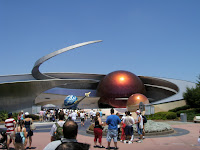



The adventures of an educator in aerospace education! solbergmargot@gmail.com













.JPG)






.JPG)





.JPG)
%2B.JPG)



NASA
Aerospace Institute - Days 1 and 2: After a lovely opening banquet to introduce the 30 participants (25 overseas and 5 US educators) and various heads of departments that helped to make this wonderful event possible, we spent our first day learning about aerospace history; including the Mercury, Gemini, Apollo and Space Shuttle programs. After that we toured the Astronaut Hall of Fame and saw many incredible items first-hand. One of the highlights included going in the fantabulous G-Force machine – a simulator much like the one which the astronauts use for training – that allowed us to find out what 4 g’s feels like (see picture of me with the vomit bag used, fortunately, only as a precaution). It was an awesome day to learn about history first hand!
Today’s factoid: When we stand on the earth’s surface we say that we are at 1 g (or 1 “gravity”). The space shuttle starts at 1.g g’s at lift-off, builds to 2.5 g’s in 2 minutes, drops to 0.9 g’s when the solid rocket boosters burnout, and then slowly builds to 3 g’s nearing main engine cutoff…cool!

